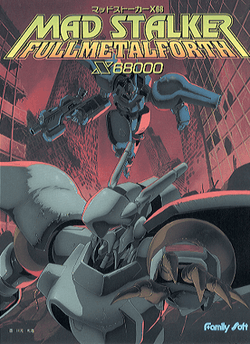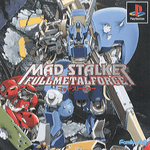Mad Stalker: Full Metal Force
| Mad Stalker: Full Metal Force | |
|---|---|
 Front cover of the Sharp X68000 version | |
| Developer(s) |
Fill-in-Cafe (Sharp X68000, Fujitsu FM Towns) Kogado Studio (PC-Engine CD-ROM²) |
| Publisher(s) |
Family Soft NEC Interchannel (PC-Engine CD-ROM²) |
| Distributor(s) | Family Soft |
| Designer(s) |
Masatoshi Imaizumi Masaki Ukyo |
| Composer(s) | Keishi Yonao |
| Platform(s) | X68000, FM Towns, PC-Engine CD-ROM² |
| Release date(s) |
Sharp X68000
FM-TOWNS
PC-Engine CD-ROM²
|
| Genre(s) | Beat 'em up |
| Mode(s) | Single-player |
Mad Stalker: Full Metal Force (マッドストーカー フルメタルフォース) is a Japanese beat 'em up video game originally produced by Fill-in-Cafe and published and distributed by FamilySoft for the Sharp X68000. The music was composed by Keishi Yonao.
Gameplay
The genre it uses is beat 'em up, but like Kung-Fu Master by Irem, it is played in a single plane field, but only scrolling toward the right. The game's controls uses a configuration of an eight-directional joystick and two attack buttons. The player uses the joystick to jump, crouch and move the character towards or away from the enemies. There are two buttons of differing strength and speed (Light and Heavy). The player can perform a variety of basic moves in any position, including grabbing/throwing attacks, while the player can perform special moves by inputting a combination of directional and button-based commands. Players control the Hound Dog throughout each stage knocking out minor enemies, followed by a boss character. If the vitality of the Hound Dog becomes empty, the game is over, and the player will have a chance to continue where he or she left off. There are six stages total with three difficulty levels.
Plot
The following plot summary is taken from the intro:
2142 A.D. Artemis City. People were about to forget all those disasters. A war ship probably built during the late war time was discovered by the military. There were a few hundred SlaveGears aboard the war ship, and were to be put under the control. Under the intention of the ruling government in power. Two SlaveGears were put under the management of the police for the purpose of experimental use. These two models were named "Hound Dog" and "Rising Dog". The manned test of Hound Dog. The main computer "Omega" of the war ship stored within the premises of military facilities suddenly began operations. "Omega" conducted network access through military channels. Omega froze all functions of Artemis City, and gave a command to the SlaveGear to put the entire city under control. "Exterminate the enemy!" Rising Dog which had not yet been modified for manned use, also had started operations under the command of Omega. The research facilities were destroyed, and one SlaveGear disappeared into the city. The police had recognized the emergency of Artemis, and had begun operations for settlement. "Code name Hound Dog. Alert! Terminate all tests immediately, and join with the forces in the city. Repeating..."
Legacy

In July 1994, Mad Stalker: Full Metal Force was ported to the Fujitsu FM Towns, featuring a Compact Disc Digital Audio version of the FM chiptune background music of the Sharp X68000 version. On September 15, 1994, it was reprogrammed by Kogado Studio and published by NEC Interchannel for the PC-Engine CD-ROM², with exclusive animated cut-scenes, some additional characters and Compact Disc Digital Audio. On July 3, 1997, a completely different version under the same title, developed by Fill-in-Cafe and published and distributed by Family Soft, was released for the PlayStation exclusively in Japan. This version was later ported to the PlayStation Network on January 12, 2011.
On September 24, 1994, Keishi Yonao composed an album titled Mad Stalker 2142, on which most of the songs are completely different from the soundtracks of the Mad Stalker: Full Metal Force video games; however, some songs were later used in the PlayStation version. It was published by Polydor Records exclusively in Japan. On December 18, 2006, D4 Enterprise's Project EGG service released the Sharp X68000 version's soundtrack exclusively on there website for download in MP3 format.
According to former Treasure designer Tetsuhiko "Han" Kikuchi, Mad Stalker: Full Metal Force and Capcom's Alien VS. Predator arcade game were the main inspirations for Guardian Heroes' design.[1]
References
- ↑ November 2012 issue of Nintendo Power magazine.